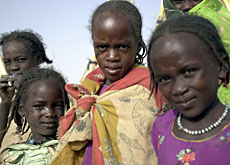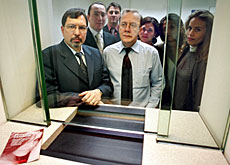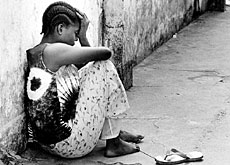Charity calls for action on child trafficking

The Swiss charity, Terre des Hommes, is calling for more to be done to tackle child trafficking, estimated to affect 1.2 million children a year worldwide.
The organisation is aiming to raise awareness about two major forms of the trade in Europe: the abuse of non-accompanied minors and commercial adoption.
A recent conference on child trafficking in Sion brought together 180 experts from 48 different countries to discuss what can be done about the growing problem.
“Most of the trafficking is underground,” said Bernard Boeton, the charity’s head of child rights. “We have some facts and figures, but it’s just the tip of the iceberg.”
The illegal trade involves minors – children under the age of 18 – being sold as cheap labour or being forced into prostitution or crime.
Many of the children come from developing countries and either end up or are transited through western Europe.
Minors
One of the main issues in Europe is that of unaccompanied minors – children who migrate abroad to seek a better life.
Boeton says that about 800 to 1,000 non-accompanied minors ask for asylum in Switzerland each year. But only ten per cent receive either a permanent or temporary residence permit.
The other 90 per cent, he says, simply disappear.
While some might be trying their luck in neighbouring countries others become the victims of traffickers, and are often forced into illegal activities such as drug dealing, prostitution or theft.
“The non-accompanied minors are not necessarily victims of trafficking when they arrive in Europe,” Boeton told swissinfo.
“But the fact that their rights are not respected, that they cannot get an official residence permit… that sometimes puts these children into the trafficking system,” Boeton added.
He said Terre des Hommes was calling on governments to be less restrictive in their policies towards child migrants.
“We are not asking for the integration of all minors… but the protection of the child – not that the child ends up on the streets in an illegal and clandestine situation.”
Adoption
Another problem is commercial international adoption. Terre des Hommes says that an increasing number of Westerners are looking to adopt a child, usually from eastern Europe or South America.
In Switzerland there are 400 to 600 of these adoptions a year.
Speaking at the conference, the charity’s Marlene Hofstetter said that both illegal means, such as forged papers or kidnap, as well as legal means – paying money to finalise the legal procedures for adoption – were still sometimes used in intercountry adoption.
She said that such adoptions were not always in the best interest of the child but that many potential parents justified their actions by saying that they could offer the child a better future.
“In the receiving countries, a huge job has to be done through awareness-building and the better preparation of the potential adoptive parents,” said Hofstetter.
“It is absolutely necessary to combat this perception of normality that has become inherent in illegal and commercial adoptions,” she added.
Protection
The organisation stressed that protection should be at the forefront of government policy on child trafficking.
This includes the application of legal instruments like the Hague Convention on Intercountry Adoption, aimed at setting down minimum standards for such adoptions, and the United Nations Convention on the Rights of the Child.
Terres des Hommes is also calling for better training for staff involved in child protection and increased coordination between countries to prevent trafficking.
Most of all, Boeton says, the charity would like “governments in the countries we are working in to recognise the facts”.
swissinfo, Isobel Leybold-Johnson
The Hague Convention on Intercountry Adoption dates from 1993.
It has been ratified by 46 countries, while seven have signed but not ratified.
The UN Convention on the Rights of the Child was adopted by the General Assembly in 1989 and came into force in 1990.
It has been ratifed by all countries except the United States and Somalia.

In compliance with the JTI standards
More: SWI swissinfo.ch certified by the Journalism Trust Initiative




You can find an overview of ongoing debates with our journalists here. Please join us!
If you want to start a conversation about a topic raised in this article or want to report factual errors, email us at english@swissinfo.ch.